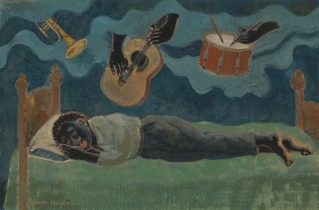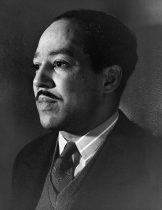During the 1920s, the Harlem Renaissance greatly impacted and diversified New York City. The Harlem Renaissance was a movement during which African American culture drastically flourished, as it developed artistically, socially, and intellectually. Throughout this era, which was also known as the dawn of the “New Negro”, black New Yorkers decided to step against the prior oppression and subordination that they had experienced due to their race, and they gained a sense of unity, integrity, and creativity.[1] By creating new forms of art, music, fashion and literature, black citizens throughout Harlem created and expressed a new sense of cultural and racial pride.
The Harlem Renaissance began when thousands of African Americans moved northward to gain more opportunities, and to escape racism and limited rights in the south. In 1917, during the time of World War I, many northern states opened factories to manufacture and provide weapons for American soldiers fighting overseas. Consequently, many black southern citizens moved to the north to work in these factories, many of which were located in New York City. Additionally, real estate companies began to build many new apartment complexes in anticipation of a population boom among white New Yorkers. However, when urban citizens unexpectedly had little interest in moving into Harlem, real estate owners agreed to begin renting their properties to black migrants from the south. This overall mass movement of African Americans from the rural south to the urban north was known as the Great Migration, and was the starting point for the Harlem Renaissance.[2]
Due to the high quantity and close proximity of black New Yorkers living in Harlem, these citizens were able to bond over their race and culture together. After discovering that the majority of their fellow neighbors had also shared common past experiences of hardship in the south, African Americans sought to unite themselves by creating a better life in Harlem.[3] They sought to end stereotypes, build a respectable reputation for themselves, and create a lasting legacy of racial pride for generations to come. Black Harlem residents began to redefine themselves and portray their potential through their art, music, and literature.

During the Harlem Renaissance, African Americans uplifted their culture through new art. This was the first time that they truly embraced creativity. Black artists expressed themselves, their interests, and the greatness of their race by creating new sculptures and paintings. In particular, one form of art that was widely practiced during this era, known as cubism, was introduced to African Americans by Aaron Douglas, who was an extremely talented black artist. This two-dimensional artistic technique, which was commonly characterized by fragmented subjects and bright, bold colors, was a strong representation of African American culture during the 1920s. Although many of the black residents of New York City were previously slaves and had experienced significant oppression and brokenness in the past, they came together to intentionally create a better life for themselves in Harlem. Additionally, the bold and vivid colors used in cubism represented the vibrancy and excitement of African American culture. Cubism truly reflected the identity of African Americans during the 1920s. Aside from painting, sculpting emerged as popular artistic method. Many sculptors and painters chose Egyptians to be the subject of their masterpieces, reflecting and honoring their ancestral African roots. Overall, the new and unique creation of art by black New Yorkers added a splash of color to African American culture all throughout Harlem, and proved the potential of black artists.[4] Today, the Studio Museum in Harlem displays a variety of both local and international art that has been inspired by African American culture, and reflects the creativity of the Renaissance era.
African American culture was further defined and improved by musicians during this era. In particular, jazz music was an iconic category of the New Negro movement, and was indigenous to African American culture. Although jazz originated in New Orleans decades prior to the Renaissance, talented black musicians, such as Louis Armstrong, brought this up and coming form of music to Harlem during the twenties. Jazz music was characterized by upbeat and improvised tunes, as well as brass instruments. Furthermore, Duke Ellington, a talented member of a band, paved the way for respectable black musicians by performing jazz shows in night clubs in New York City. He gained fame by performing at the Cotton Club, which was a popular nightclub at the time. For anyone who would have visited this social event at the time, he or she would observe how racially divided it was. Although black New Yorkers performed, they were not welcomed in the audience. Despite being prohibited from attending this club, musicians such as Duke Ellington and his orchestra impressed thousands of white audiences with their innovative and captivating skills.

Jazz musicians truly helped to bring respect and greatness to African American culture. Not only did they gain they recognition and renown from all over the urban area, but they developed a way to creatively express themselves in a way that no other culture had done before. Through jazz music, African Americans in Harlem truly redefined themselves. [5] The National Jazz Museum in Harlem, which is affiliated with the Smithsonian, is a highlight for New York visitors today, as it continues to preserve and celebrate jazz traditions in the twenty-first century. Although the Renaissance itself ceases to exist today, this musical museum continues to add an artistic and lively touch to the urban environment of Harlem.
Black New Yorkers in Harlem recreated their identity through literature as well. Perhaps it was through this literature that African Americans portrayed their determination to gain rights and respect most clearly. Through their art and music, they displayed the innovation and creativity of their unique culture. Although they did so in their writing as well, they utilized their intellectual skills to take a stand against stereotypes, racism, and inequality, and to demand justice, respect and equality for all blacks. During the 1920s, African Americans began to write poems, books, journal entries, magazines and newspaper articles for the first time. This took great courage and motivation, since African Americans had been viewed as inferior and illiterate by whites. In her book, The Harlem Rensaissance, author DeAnn Herringshaw described how racist publication companies were toward African Americans during the 1920s. Herringshaw wrote, “Whites largely ignored African Americans’ contributions to the collective culture. The biggest publications employed white writers and editors who catered to their white audiences. Any images or stories of African Americans were nearly always negative or employed racial stereotypes that made black people seem inferior”.[6] Infuriated that all publications were intended for white audiences, black writers began to publish their own works so that they might have a voice in society.
One of the most prominent leaders in this period of literary growth was Langston Hughes. In his writing, he addressed the issues of inequality, racism and stereotypes, and he wrote with a militant tone of determination to enact change. In 1930, a newspaper journalist, Amey Smyth, published a review of one of Langston Hughes’ books in The Detroit Free Press. Smyth wrote referred to Hughes’ writing when she wrote, “Here there is pride without arrogance…It is rather the new spirit of what has been termed the Negro Renaissance”. [7] Through Smyth’s book review, it comes clear that Hughes truly wrote with a sense of racial pride. He did not write to cause tension or violence; rather, his words demanded equality. Smyth also reported that, “Langston Hughes has stated their creed simply and forcefully: ‘We younger Negro artists who create now intend to express our individual dark-skinned selves without fear or shame. If white people are pleased, we are glad. If they are not, it does not matter. We know we are beautiful’”.[8] Hughes’ extremely powerful and confident words conveyed his fearlessness. He set an outstanding example for his fellow writers, who also published their literature despite the condescending attitudes of white publication companies. More importantly, Langston Hughes inspired his fellow African Americans, both in New York and across the United States, to lift their heads high and to be proud of their race. He urged them to boldly express themselves and to stand against racism and stereotypes.

Through the avenues of art, music and literature, African American culture certainly blossomed and reflected the great potential of black New Yorkers during the twenties. By fostering diversity in Harlem, the efforts of black citizens spread far beyond that neighborhood. New York City as we know it today, is among the most diverse areas of the world. The Harlem Renaissance undoubtedly added to this beautiful variety of culture, and cultivated a sense of pride, optimism, and confidence within the hearts and minds of African American New Yorkers.
[1] Cheryl Wall, The Harlem Renaissance: A Very Short Introduction (New York: Oxford University Press, 2016), 5.
[2] Keira Stevenson, “Harlem Demographics”, The Harlem Renaissance (2009), 1.
[3] Ushistory.org, “The Harlem Renaissance”, US History, www.ushistory.org/us/46e.asp, accessed March 31,2020.
[4] “Uncovering America”, National Gallery of Art, https://www.nga.gov/education/teachers/lessons-activities/uncovering-america/harlem-renaissance.html, accessed March 30, 2020.
[5] DeAnn Herringshaw, The Harlem Renaissance (Edina, Minn : Abdo Publishing, 2012) 83.
[6] DeAnn Herringshaw, The Harlem Renaissance (Edina, Minn : Abdo Publishing, 2012) 49.
[7] Amey Smith, “Reviews of Current Books: Negro Writings In Anthology”, The Detroit Free Press, February 9, 1930.
[8] Amey Smith, “Reviews of Current Books: Negro Writings In Anthology”, The Detroit Free Press, February 9, 1930.